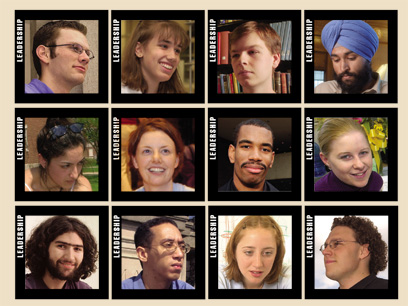
Leadership

When asked to define it, even those who study leadership and who study people
widely considered to be leaders turn first to examples.
"A leader is someone like . . ." begins the definition. Or, "A
leader is someone who. . . ."
Then the names-some well known, some not so well known-tumble forth. Out of
that, the common characteristics start to emerge: ambition, brains (but not
necessarily genius), drive, concern for others, energy. . . .
But, says Richard F. Fenno Jr., Distinguished University Professor and Kenan
Professor of Political Science-and himself one of the nation's leading scholars
of Congress (an entire subset of leaders unto itself)-a key element in defining
leadership is a person's social and cultural environment.
"It is difficult to say how much of leadership has to do with personal
characteristics and how much has to do with context," Fenno says. "A
leader usually doesn't stand up in the middle of nowhere."
And leaders usually have a solid, but often invisible, support system that
has helped nurture their talents, says Nora Bredes, director of the Anthony
Center for Women's Leadership.
Such personal contexts, she says, have traditionally been overlooked by historians
and in popular perceptions of leadership. The center, which helps teach and
promote leadership among women, uses the friendship between Elizabeth Cady Stanton
and Susan B. Anthony as a prime example. Together, Stanton and Anthony achieved
leadership roles beyond what they could have alone.
"We try to look at relationships," says Bredes, who as a former state
legislator has seen many variations of leadership in action. "Leadership
happens in a lot of small ways that sometimes are less visible."
Visible or not, leadership is, at its essence, what happens between people.
Between parents and children, teachers and students, colleagues and coworkers,
executives and employees, governors and governed.
Is there a more fertile context for exploring that human interaction than a
university such as Rochester?
Rochester has long challenged students to find a sense of themselves in the
world and to find a sense of engagement with their fellow human beings across
a broad spectrum of relationships.
Inspired by the theme for the College's annual Meliora Weekend, October 11-13,
Rochester Review set out to chronicle some examples of the ways that
Rochester provides the context for leadership-exemplified by those who hope
to become leaders in their academic fields or their communities as well as by
those who already have achieved such status.
Our sample spotlights just a few students, faculty, and alumni from the many
possible examples within the University family. (Do you have an example of a
Rochester-related leader? Please write to us, and we'll publish them as we can
in upcoming issues. The address is Rochester Review, 147 Wallis Hall, University
of Rochester, Rochester, NY 14627-0033; e-mail: rochrev@admin.rochester.edu.)
We, too, found that leadership is often easy to spot but difficult to characterize.
We were impressed, though, with how many examples there are to choose from at
Rochester.
"Leadership is where you find it," says Fenno. "And you will
find it everywhere."
-Editor
Maintained by University Public Relations
Please send your comments and suggestions to:
Rochester Review.
|
![[NEWS AND FACTS BANNER]](/URClipArt/news/titleNewsFactswide.jpg)


![[NEWS AND FACTS BANNER]](/URClipArt/news/titleNewsFactswide.jpg)

